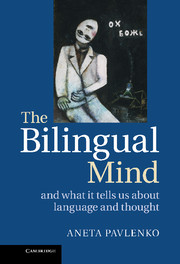Book contents
- Frontmatter
- Contents
- List of Tables
- Acknowledgments
- Preface
- 1 The Sapir-Whorf hypothesis and the bilingual turn in the study of language and cognition
- 2 Material worlds
- 3 Multidimensional worlds
- 4 Dynamic worlds
- 5 Narrative worlds
- 6 Discursive worlds
- 7 Emotional worlds
- 8 The bilingual mind and what it tells us about language and cognition
- References
- Author index
- Subject index
4 - Dynamic worlds
Linguistic construal of motion events
Published online by Cambridge University Press: 05 June 2014
- Frontmatter
- Contents
- List of Tables
- Acknowledgments
- Preface
- 1 The Sapir-Whorf hypothesis and the bilingual turn in the study of language and cognition
- 2 Material worlds
- 3 Multidimensional worlds
- 4 Dynamic worlds
- 5 Narrative worlds
- 6 Discursive worlds
- 7 Emotional worlds
- 8 The bilingual mind and what it tells us about language and cognition
- References
- Author index
- Subject index
Summary
Most observers of the Navajo agree that motion pervades the Navajo universe … In the Navajo films themselves and in the way they talked about what they were going to do in their films, we can see many examples of this inordinate need both to portray motion precisely and to use it as a recurrent theme.
Worth & Adair, [1972] 1997: 200–201How can we find out what the world looks like through someone else’s eyes? We can imagine it, as writers commonly do, or we can try to reconstruct it through people’s words, as linguists do, we can even use eye-tracking equipment, as psycholinguists do nowadays. In 1966, communications scholar Sol Worth and cultural anthropologist John Adair, inspired by Whorf’s ideas, decided to examine how people film events and then sequence them through the editing process in the hope that “processes involved in cognition might be better understood if the way in which people produced a structure of visual sequences were compared to the way in which the same people structured their verbal language” (Worth & Adair, [1972] 1997: 28).
In order to see the world Through Navajo Eyes (1997), Worth and Adair taught film-making and editing to a group of six Navajos in Pine Springs, Arizona, where Adair had conducted his previous research. Pine Springs at the time was a small traditional community of about six hundred people, with a high preponderance of silversmiths and weavers, and had not yet been invaded by television – many of its inhabitants had seen no or very few films. Navajo continued to serve as the language of the home and the community, while English fluency varied by generation: most of the population under thirty was bilingual, while many of the older people spoke no English whatsoever. The six project participants were members of the younger generation who lived their lives through the means of Navajo and English (in contacts with the outside world), while many of their parents and grandparents were monolingual Navajos.
- Type
- Chapter
- Information
- The Bilingual MindAnd What it Tells Us about Language and Thought, pp. 126 - 168Publisher: Cambridge University PressPrint publication year: 2014



